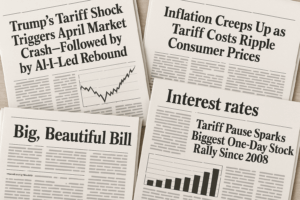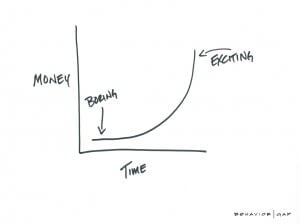
Don’t Go Chasing Waterfalls
Investment ManagementAug 06, 2021
Whether it is poolside, in the car, or at beach, there is nothing like revisiting a good summer jam this time of year. For anyone around in the 1990’s, chances are you remember the song “Waterfalls” by TLC. It was released in 1995 and labeled by Billboard as the definitive hit of that summer. It spent seven weeks at number 1 on the Billboard Hot 100 and earned two Grammy nominations. It is arguably one of the catchiest songs of that decade. So, what does it have to do with investing? First, let’s assess where we are heading into the final weeks of summer 2021.
We do not put a lot of weight into forecasts, economic predictions, or market calls. They are usually wrong and rarely useful, even though there are lots of people paid to make them. That being said, we do our best to understand where we are in the business cycle to help better inform our decision-making. By focusing on a few key factors, it helps us prepare for whatever will come next while avoiding being bogged down by “false stimuli”, or information that does not add a lot of value. While we believe the future is largely unknowable, understanding patterns from the past can help investors block out the noise and manage their risk appropriately. As Howard Marks is fond of saying,” you cannot predict, but you can prepare”. For the purposes of this blog, we will focus on two factors we are focused on: the credit cycle and fundamentals.
The credit cycle refers to the different phases involved in liquidity (cash) being available to borrowers and investors. Central Banks play a major role in determining this through interest rates and monetary policy . In the U.S., the main entity involved in managing the credit cycle is known as the Federal Reserve (the Fed). Monetary policy is important because it provides a barometer for how “easy” or “tight” conditions are financially. When lending standards are eased and rates are low, it is considered stimulative to the economy and the markets, as borrowers have easy access to debt that is cheap. Historically the Fed has lowered rates to help the economy along in times of weakness, which allows more money to flow through the financial system and the economy. This also leads investors to become more comfortable taking risk. Think of it in terms of housing as an example. Borrowers are generally more likely to borrow and spend on new houses when interest rates are lower.
When interest rates go up, financial conditions tighten. Credit becomes more expensive and harder to come by as lending standards becomes more stringent. This could happen through some combination of the Fed raising rates, and/or people being fearful about losing money. This generally leads to less borrowing and spending, with people taking less risk as liquidity dries up. This is why raising interest rates is a tactic used by the Fed to rein things in when the economy is overheating.
Right now, we are seeing the easiest financial conditions in history. Interest rates are the lowest they have ever been, and the Fed is buying $120 billion of treasury and mortgage bonds every month, which creates even more liquidity (cash) entering the system. They have been doing this since March of 2020 when the initial shock of the pandemic and lockdowns sent things into a tailspin. The Fed has stated there is no plan to raise interest rates any time soon, and the ending of bond purchases will occur at a slow and methodical pace at some point in the coming months. These conditions have raised worries about inflation.
Fed policy has helped to add a lot of cash to the system, and it is looking for somewhere productive to go. As the cost of capital has gone down substantially, asset prices have gone up. So has risk taking. This is true whether you are talking about stocks, bonds, housing, commodities, and even crypto, art, and sports memorabilia. In the short to intermediate-term, the amount of liquidity (cash available for investment) in the system can go a long-way in dictating price-levels for assets. History tells us this phase of the credit cycle where borrowing is easy and money is cheap can’t last forever, but it can go on for a while.
Fundamentals refer to corporate earnings and growth prospects, corporate and household balance sheets, overall economic growth, and other important metrics. These factors help in determining the value of assets over the long-term. Earnings in particular are very important. This is because when you buy shares of a stock, you are buying an ownership stake in a company that gives you a right to a portion of their future earnings. At a higher level, if companies grow their profits over the long-term, the overall market can continue moving higher. Although we have seen volatility, shocks, and crashes throughout history, profits on the whole trend upward as companies become more productive and the population grows. The stock market just follows this trend.
The current environment is an interesting one. Comparisons from a year ago are hard to measure as the effects of the pandemic have created noisy metrics that are hard to gauge. In other words, there aren’t a lot of good “apples to apples” comparisons right now in the data. On the whole though, many companies have reported strong earnings, and economic growth remains positive. At the same time we have seen a lot of head-scratching valuations that may become hard to justify. There is also a lot of gambling going on in lower quality investments where people are trying to get rich quick. Inflation, fiscal policy, and geopolitical risks are just a few factors that could change the current fundamentals quickly.
It is the push and pull of liquidity (cash) available and fundamentals that help dictate the duration and velocity of a business cycle. Right now, there are a lot of quality businesses growing their earnings, innovating, and positioning themselves for long-term success. There is also speculation in questionable investments, FOMO investing, and cheap capital chasing asset prices higher. Remaining level-headed isn’t easy at this stage.
In our view, rather than looking for overnight success and grand slam investments, investors in this environment should be as diligent as ever about finding the right mix of offense (growth) and defense (preservation) that suits them over the long-term, while understanding what they own and why …or as T.L.C. famously put it in the summer of ’95: “Don’t go chasing waterfalls, stick to the rivers and the lakes that you’re used to.”
Citations
Thinking About Macro (memo), Howard Marks- Oaktree Capital, August 2021
Tech, inflation, and the tyranny of the numerator, LT3000 Blog, May 13, 2021
Grant’s Interest Rate Observer, James Grant- Almost Daily Grant’s, July 28, 2021


